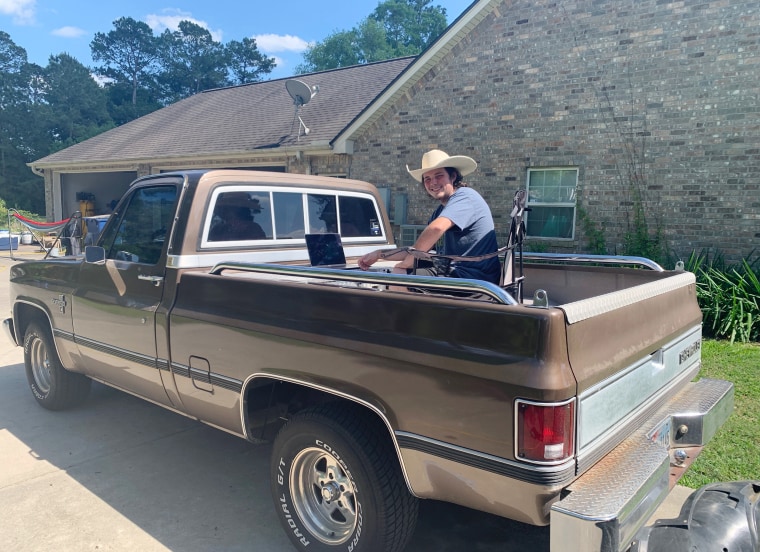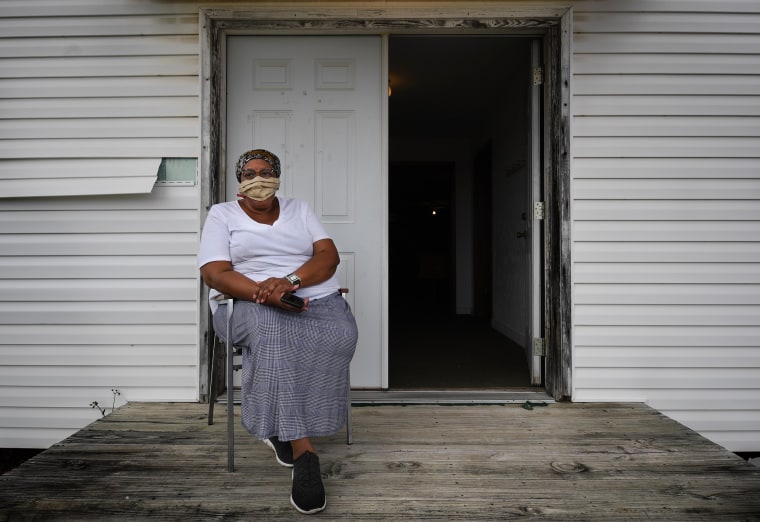The parking lot of Free Pentecostal Holiness Church in the historic town of Tatums, Oklahoma, is a little busier these days.
The grassy areas on either side of the small, white building now serve as the town's main Wi-Fi hot spot. People in cars parked outside the church's doors can access broadband internet, which isn't common or cheap in the town of about 160.
"Internet in rural areas is a rip-off, and I know this because I pay $98 a month for slow, supposedly high-speed internet," said Liz Jenkins-Austin, a volunteer for the Oklahoma Missionary Baptist State Convention, who helped set up the hot spot. "And so, mostly people at the poverty level here, most of those parents can't afford internet service."
At high schools and libraries, in parking lots and side streets, Americans are tapping public Wi-Fi hot spots that are now serving as lifelines during the coronavirus pandemic.
The hot spots had already served as crucial stopgaps for people, particularly students, before the outbreak. But with the pandemic pushing large parts of American life online, including work, school, medical care, religion and socializing, the internet connections are now a crucial part of daily life for the people who depend on them.
Tatums is a historically black town, one of more than 50 founded after the Civil War as freed slaves looked to the new state of Oklahoma for land. Only about 13 such towns still exist, according to the Oklahoma Historical Society.
In a search of help, Jenkins-Austin appealed to the Information Technology Disaster Resource Center, or ITDRC, a nonprofit that helps provide internet service and other technology needs to people in times of crisis. Jenkins-Austin wrote in a letter that 25 students in the community had no internet access, because it's either unavailable or too expensive. More than a third of Tatums' residents live below the poverty line, according to census data.
Last Friday, the center activated the Tatums hot spot, one of many technology-focused projects it has launched in recent weeks.
"We're just trying to make sure nobody got left behind in being able to keep up with their schoolwork," said Carolyn McConnell, 63, who lives just outside Tatums.
Just how much of the United States has access to high-speed internet remains the subject of debate. A recent report from the Federal Communications Commission found that about 85 percent of Americans have access to broadband internet, which delivers at least 25 megabits per second.
Many consumer advocates say the numbers are inflated because of the FCC's reporting procedure. Internet providers are also being scrutinized for how they report coverage. AT&T recently had to clarify that it doesn't offer broadband internet service in 3,600 census blocks in 20 states, despite initially claiming that it did.
Jessica Rosenworcel, a Democratic member of the FCC, issued a strong dissent to the FCC report over its findings that broadband internet is being built "in a reasonable and timely fashion."
"Check the headlines decrying the lack of broadband in this country," she wrote. "Look at Congress constantly pressing for new programs to extend the reach of internet access in the United States. See governors establishing committees and support systems to expand broadband to those who are not connected. Take note of mayors everywhere clamoring for better broadband so their communities have a fair shot at digital-age success."
Chris Hillis, a co-founder of ITDRC, said his organization has responded to more than 100 disasters since it started in 2008, but never anything like the coronavirus pandemic. The ITDRC, which is funded by major tech companies, including a recent $2 million grant from Facebook, has received more than 150 requests across 28 states in relation to the outbreak.
Elsewhere, Wi-Fi hot spots from schools and institutions are in demand.
Hunter Christman, 18, who attends Lamar State College Orange, said his hometown, Orangefield, Texas, is too rural for internet service. So he's been driving his 1981 Chevy Silverado to the school's parking lot to do his schoolwork. He could use the school lab, but he said he's trying to maintain social distance.
"I bring a lawn chair and I set it up in the bed of my truck and I have a toolbox in my truck that I put my computer on, and that's my setup," Christman said.

Many other people are congregating around whatever Wi-Fi hot spots they can find.
Brooke Axelrod, 21, who is studying criminal justice at Roanoke College in Salem, Virginia, said she and her girlfriend go to a high school parking lot multiple times a week and work in her car because where she lives, near Amherst, Virginia, is too rural to get an internet connection.
Still, it's hard to keep up.
"My LSAT prep courses, I haven't been able to take that at all, basically, because I can't connect to the internet, and it's three days a week for four hours every day of just a video class," Axelrod said.
Urban communities also struggle with connectivity issues, but rural areas are particularly in need of the opportunities that fast internet can provide.
Kathryn de Wit, manager of the broadband research initiative at the Pew Charitable Trusts, a nonprofit public policy organization, said that there have been some bright spots in recent years getting broadband to more people — she pointed to Tennessee as a particularly good example — but that development can be slow.
"It will take time and resources to solve in the same way that it takes time for a road or a highway to be built," de Wit said. "Building the internet's infrastructure takes time."
The payoff, she said, can be significant.
"Ten jobs at the national level doesn't seem like a lot, but 10 jobs is a lot to a community of 10,000," de Wit said.
The ITDRC hot spot is already making a difference. Resheedia Thrash, 62, said she has lived in Tatums for 30 years. The town has struggled to keep its younger people from moving away, leaving the community to slowly dwindle.
She said the hot spot has brought some joy and excitement to the community, particularly for younger people who need it for their education.
"We were waiting on someone to open the door for us," Thrash said. "I'm still excited even though I don't know anything about the internet."

